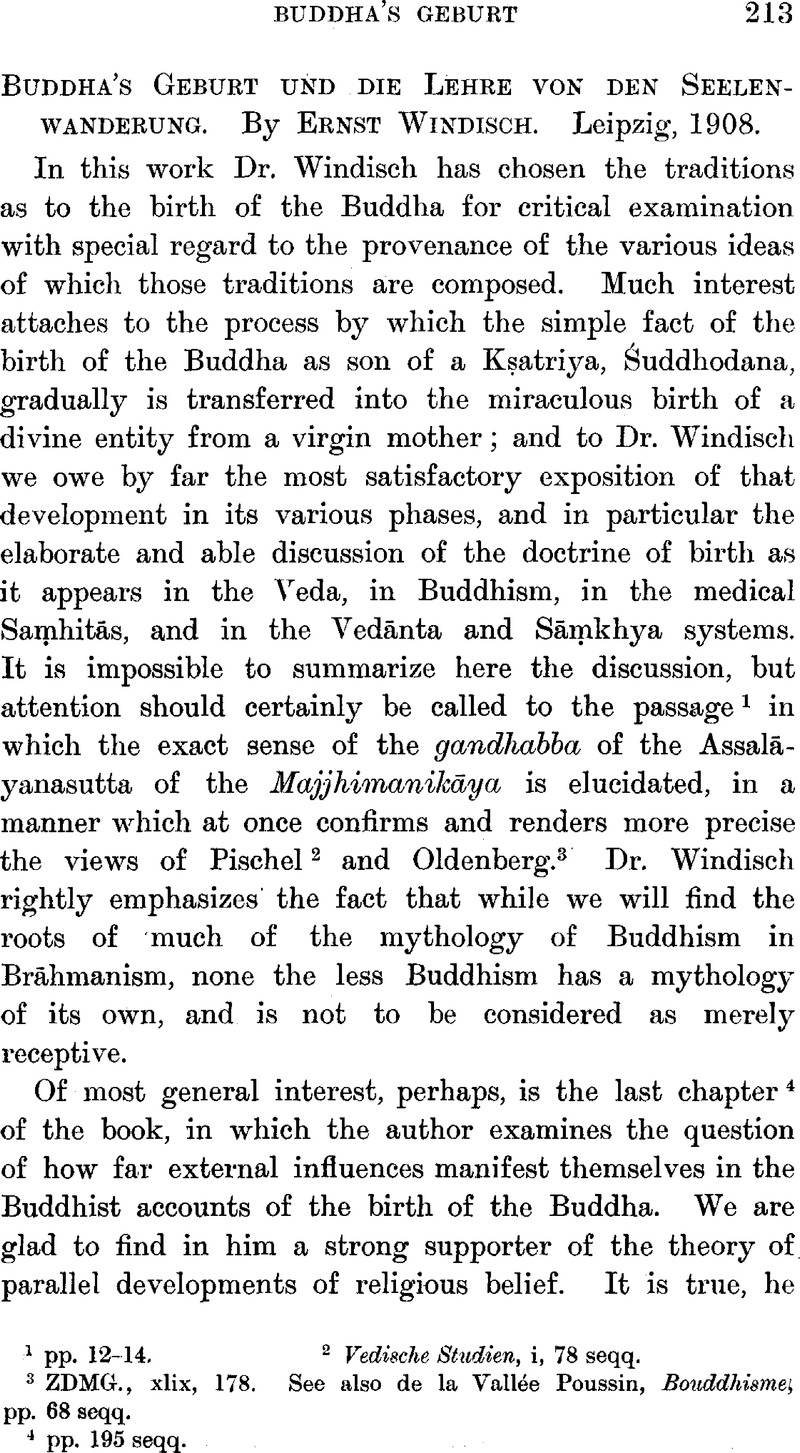No CrossRef data available.
Article contents
Buddha's Geburt und die Lehre von den Seelenwanderung. By Ernst Windisch. Leipzig, 1908.
Review products
Published online by Cambridge University Press: 15 March 2011
Abstract

- Type
- Notices of Books
- Information
- Copyright
- Copyright © The Royal Asiatic Society 1910
References
page 213 note 1 pp. 12–14.
page 213 note 2 Vedische Shidien, i, 78 seqq.
page 213 note 3 ZDMG., xlix, 178. See also Poussin, de la Vallée, Bouddhisme, pp. 68 seqqGoogle Scholar.
page 213 note 4 pp. 195 seqq.
page 214 note 1 p. 58, n. 1.
page 214 note 2 Cf. JRAS., 1909, pp. 569 seqq.
page 214 note 3 At p. 179 Windisch refutes Speyer's view (ZDMG., lvii, 108) that chaddanta means “having the five senses and the mind restrained (dānta).
page 214 note 4 Cf. pp. 175, 176.
page 214 note 5 p. 139, n. 1. Cf. Poussin, de la Vallée, Bouddhisme, p. 39, n. 1Google Scholar.
page 215 note 1 pp. 58 seqq.
page 215 note 2 See also JRAS., 1909, pp. 574 seqq. Cf. also Poussin, de la Vallée, Bouddhisme, p. 61Google Scholar.
page 215 note 3 Cf. ṚV., x, 14, 12, and x, 18, 3 seqq., where the idea is repeatedly set out. Vedic Indians do not pray for death conceived as life in heaven. The “parallel” passage, ix, 44, 5, cited by Boyer is not really parallel at all, as it has no clause to complete it.
page 215 note 4 See JRAS., 1909, p. 575.
page 215 note 5 pp. 62, 63. Cf. JRAS., 1909, p. 606.
page 216 note 1 pp. 62, 63; and see his note in Sächs. Ber., 1907, pp. 111 seqq.; Oertel, JAOS., xix, 111; my Śāṅkhāyana Āraṇyaha, p. 17.
page 216 note 2 p. 33, n. 1.
page 216 note 3 Aitareya Āranyaha, pp. 304, n. 23; 367.
page 216 note 4 p. 71, n. 2. Dandśūka, which occurs also in Nirukta, Pariśiṣṭa, ii, 9, is given by the commentary as the equivalent.
page 216 note 5 ZDMG., xlviii, 63. Parasvant is found in ṚV., x, 86, 18; AV., vi, 72, 2; Maitrāyaṇī Saṃhitā, iii, 13, 10. Cf. Aitareya Araṇyaha, p. 377, n. 1.
page 216 note 6 pp. 48 seqq. For the latest view of Dr. Hoernle on the question of Caraka's date, see JRAS., 1909, pp. 886, 887, and compare my note, ZDMG., lxii, 136.
page 216 note 7 Cf. also JRAS., 1909, p. 882.
page 216 note 8 Cf. pp. 10 seqq.
page 216 note 9 Bouddhisme, pp. 33 seqq. Cf. my note, JRAS., 1909, p. 577, n. 1.
page 217 note 1 Bouddhisme, pp. 54 seqq.
page 217 note 2 La formule bouddhiqiie des douze causes, Geneva, 1909Google Scholar.


